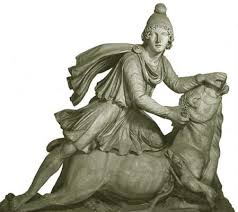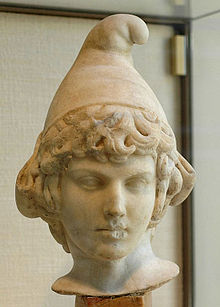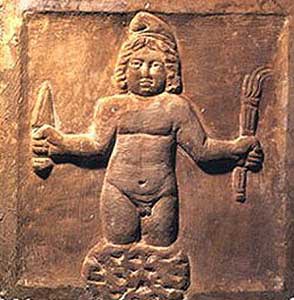|
Mithras

Aliases: Mithra, Mitra
Locations: Persia (Iran), Mesopotamia (Iraq), Palestine, Syria, Armenia, Hungary, Egypt, Africa, Rome, Germany, Switzerland, France, Spain, UK
Cities: Garni, Rome, Aquincum, Dura-Europas, London
Estimated Date: 0s B.C. - 300s A.D.
He is equated with Apollo and Prometheus and wears the same cap as Attis and a god similar to Dionysus
The Clementine Homily, dated to the 200s A.D., equates Mithras with Apollo and confirms the Mithras mysteries are based on the changing of the seasons. Tertullian compares the baptisms of Mithras to that of Osiris' wife Isis and Apollo. However, whereas Attis and Apollo venerated the mother goddess, Mithraism venerated the father, making Pater the final seventh rank in a planetary-based tier system in a male-only religion. An Egyptian glossary equates Mithras with Prometheus, the Greek equivalent for Dumuzi’s father, Enki. Mithras is typically depicted wearing the same Phrygian cap worn by Attis and Apollo's Dionysian enemy, Marsyas.

Attis in a Phrygian cap, dated 100s A.D.
And I must ask you to think of all such stories as embodying some such allegory. Look on Apollo as the wandering Sun (peri-polon), a son of Zeus, who was also called Mithras, as completing the period of a year. And these said transformations of the all-pervading Zeus must be regarded as the numerous changes of the seasons, while his numberless wives you must understand to be years, or generations. For the power which proceeds from the aether and passes through the air unites with all the years and generations in turn, and continually varies them, and so produces or destroys the crops. And ripe fruits are called his children, the barrenness of some seasons being referred to unlawful unions.
For washing is the channel through which they are initiated into some sacred rites— of some notorious Isis or Mithras. The gods themselves likewise they honour by washings. Moreover, by carrying water around, and sprinkling it, they everywhere expiate country-seats, houses, temples, and whole cities: at all events, at the Apollinarian and Eleusinian games they are baptized; and they presume that the effect of their doing that is their regeneration and the remission of the penalties due to their perjuries.
Mithras: Prometheus, according to others the sun among the Pers[ians].”
He is born of a virgin
An inscription on a Seleucid Temple in Iran dated to the 200s B.C. reads “Anahita, as the Immaculate Virgin Mother of the Lord Mithra.” While there is only one primary source for the “virgin birth” claim, and it has been shown to be very difficult to locate, the quote about Mithras being born of the virgin was published in 1983 by Mary Boyce, a British scholar on Iranian languages and Zoroastrianism who is so respected, the Royal Asiatic Society award for outstanding contributions to the study of religion is called the “Boyce Prize.”

Mithras born from the rock
He may have been born on the Winter Solstice
Mithras scholar M.J. Vermaseren placed the birthday of Mithras on December 25th, although this is still very controversial. In Introduction to the New Tesetament, Helmut Koester writes, “Little information is available in ancient literature; an interpretation must rely almost exclusively on pictorial representations. Mithras was born from a rock on 25 December (the day of the winter solstice); shepherds bring gifts.”
His followers were “born again”
Koester writes that the Mithras initiate is called “reborn” and becomes a soldier of Mithras through an oath.
He has a baptism sacrament performed for the remission of sin
The third century apologist Tertullian compares says the baptism of Mithras was done to atone for sin.
For washing is the channel through which they are initiated into some sacred rites— of some notorious Isis or Mithras. The gods themselves likewise they honour by washings. Moreover, by carrying water around, and sprinkling it, they everywhere expiate country-seats, houses, temples, and whole cities: at all events, at the Apollinarian and Eleusinian games they are baptized; and they presume that the effect of their doing that is their regeneration and the remission of the penalties due to their perjuries.
His torchbearer uses a serpent pole in a ceremony that was also used for healing by Moses and referenced by Jesus as a symbol of resurrection

Relief dated 100s-200s A.D. showing Mithras slaying a bull on one side
and a torchbearer pointing a caduceus at the baptismal altar on the other
A Roman Mithraic relief dated to the 100s or 200s A.D. portrays one of the torchbearers of Mithras, called Cautes, dressed as Mithras, standing before a baptismal altar with a snake coiled around the base, one of them holding up a rams horn to Sol Invictus and Mithras as they stand by a sacraficed bull, and the other pointing a caduceus staff down to the baptismal font. The caduceus was also used by Dumuzi's companion, Gizzida, and by Apollo. Moses used a cadeucus called Nehushtan in Exodus 15 to heal the Israelites from “fiery serpents”, and John 3:14 equates Jesus with the bronze serpent, saying both needed to be lifted up. A Mithras relief dated to 100s or 200s A.D. shows two torchbearers of Mithras,
He has a sacramental ritual of bread and water
The second century Chrsitian apologist Justin reports that Mithras worship involved a Eucharist of bread and water, which, like the other similarities between other mystery cults, were supposedly copied by devils before it actually happened.
And this food is called among us Εὐχαριστία [the Eucharist], of which no one is allowed to partake but the man who believes that the things which we teach are true, and who has been washed with the washing that is for the remission of sins, and unto regeneration, and who is so living as Christ has enjoined. For not as common bread and common drink do we receive these; but in like manner as Jesus Christ our Saviour, having been made flesh by the Word of God, had both flesh and blood for our salvation, so likewise have we been taught that the food which is blessed by the prayer of His word, and from which our blood and flesh by transmutation are nourished, is the flesh and blood of that Jesus who was made flesh. For the apostles, in the memoirs composed by them, which are called Gospels, have thus delivered unto us what was enjoined upon them; that Jesus took bread, and when He had given thanks, said, “This do ye in remembrance of Me, this is My body;” and that, after the same manner, having taken the cup and given thanks, He said, “This is My blood;” and gave it to them alone. Which the wicked devils have imitated in the mysteries of Mithras, commanding the same thing to be done. For, that bread and a cup of water are placed with certain incantations in the mystic rites of one who is being initiated, you either know or can learn.
He saves his followers through a blood sacrifice
In the Santa Prisca in Rome, it is said of Mithras: “You saved us by shedding the eternal blood”.
He has a sacrament of resurrection
The third century Christian church father Tertullian says that Mithras worship involved an “image of resurrection” or a “mock resurrection”, which must have represented the resurrection of either Mithras or his followers.
The question will arise, By whom is to be interpreted the sense of the passages which make for heresies? By the devil, of course, to whom pertain those wiles which pervert the truth, and who, by the mystic rites of his idols, vies even with the essential portions of the sacraments of God. He, too, baptizes some—that is, his own believers and faithful followers; he promises the putting away of sins by a laver (of his own); and if my memory still serves me, Mithra there, (in the kingdom of Satan,) sets his marks on the foreheads of his soldiers; celebrates also the oblation of bread, and introduces an image of a resurrection, and before a sword wreathes a crown. What also must we say to (Satan’s) limiting his chief priest to a single marriage? He, too, has his virgins; he, too, has his proficients in continence.
He was worshipped in mystery cults in the Roman era
In Introduction to the New Testament, Biblical scholar Helmut Koester surmises that the “Iranian Mithras cult assumed the features of a mystery religion during its westward migration”. There were sanctuaries of Mithras built during this period in many places in the east as well, including Mesopotamia, Africa and Egypt. The cult officials were known as the magi, a priestly cast from Media area of southeastern Turkey and northwestern Iran. However, nothing indicates that this Mithraic cult of the Hellenistic period was a mystery religion, nor that its Iranian ingredients were instrumental in the development of the Mithras mysteries of the Roman world. According to Plutarch, the cult was first adopted by Cilician pirates settled by Pompey in the western provinces. Koester writes that Mithras worship was the biggest and most organized mystery cult up until emperor Julian, himself a Mithras initiate.
His mysteries were compared to Christianity
The second century philsopher Celsus criticized Christanity by comparing it to the mysteries of Mithras. The third century theologian Origen responded by comparing the mysteries of Mithras to the other mysteries of Greece and Egypt.
After this, Celsus, desiring to exhibit his learning in his treatise against us, quotes also certain Persian mysteries, where he says: “These things are obscurely hinted at in the accounts of the Persians, and especially in the mysteries of Mithras, which are celebrated amongst them...
Now, whatever be the case with regard to these,—whether the Persians and those who conduct the mysteries of Mithras give false or true accounts regarding them,—why did he select these for quotation, rather than some of the other mysteries, with the explanation of them? For the mysteries of Mithras do not appear to be more famous among the Greeks than those of Eleusis, or than those in Ægina, where individuals are initiated in the rites of Hecate. But if he must introduce barbarian mysteries with their explanation, why not rather those of the Egyptians, which are highly regarded by many, or those of the Cappadocians regarding the Comanian Diana, or those of the Thracians, or even those of the Romans themselves, who initiate the noblest members of their senate? But if he deemed it inappropriate to institute a comparison with any of these, because they furnished no aid in the way of accusing Jews or Christians, why did it not also appear to him inappropriate to adduce the instance of the mysteries of Mithras?
The Pope's hat might be named after him
The name of the pope’s large hat, the mitre, may be etymologically linked to Mithras.
Next God: Sol Invictus
The Dying-and-Rising Gods
Leave Comments Here
|

